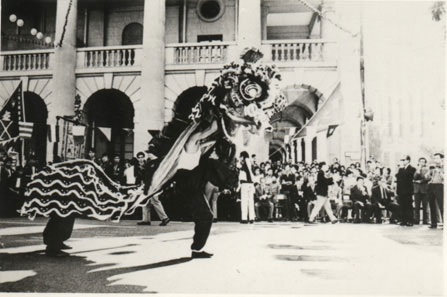 |
|
HISTORY
The "Fu Hok Sheung Ying Kuen" (Tiger-Crange Fist Form) traces its origin to the legendary Shaolin monks of the Tang Dynasty " (Circa 618-907 AD). These judiciously patriotic Knights of Cloth distinguished themselves by passing on to worthy disciples "Kung Fu" form of the highest order. These students of the revered monks abided by a strict code of the revered monks abided by a strict code of ethics and honor to assisting the oppressed and not to incite violence. The cult became more organized through the ages and gathered momentum during Emperor Chien Lungs' reign in the 18th century. The shaolin monastery in Fukien was at once a symbol of respect and jealousy arose from other sects. Eminent among the tutor-monks of the period was Tzesen, famed for his fiery sense of justice, who imparted his mystic expertise to Hung Hay Goon.
Hung went further south to establish the "Hung Gar Fu Hok (Tiger-Crane) System". The emphasis of the old style was on stability, highlighting the solid guard, short bridges, and sturdy stance. A manifestation of this feature was indicated by the amount of room it took to practice - one of the traditional forms required no more than the area of four tiles. After its establishment in Kwangtung province the "Hung Gar" style was so highly regarded that it was recognized as the "Southern Fist System".
A century later, a Hung Gar practitioner, Wong Fei-Hung, began to see the limitations of the style. Although the sturdiness and stability posed good ground for defense, the rigidity suffered in mobility and offense. With this in mind, Wong began to modify, and the result was the "Fu Hok Sheung Ying Kuen" (Tiger-Crane Fist Form).
After wong's death, this style was propagated by his disciple Lam Sai-Wing, who in turn passed it on to his nephew Lam Cho. The latter, at the mellow age of 85, is reigning grand master of the Hung Gar Fu Hok System in Hong Kong, where his following is phenomenal.
Since Kung Fu fever gripped the world following the late Bruce Lee's celluloid epics, the Chinese martial arts scene has a marked slip in standards and the advent of numerous self-proclaimed "sifus" (masters) who cashed in on the phenomenon. There are those determined to ensure that the art survives intact by exercising stringent discipline in their teaching, thus counteracting this wave of commercialism. One teacher is Augustine Lee Yat-Ming, a top disciple of Lam Cho's. Lee founded the Lee Yat-Ming Physical Training School in 1964. Lee was only interested in Tiger-Crane as a mode of keeping physically fit and mentally alert. Not even his closest comrades in the then Hong Kong Royal Naval Volunteer Reserve and subsequently the British Army Aid Group in China during World War II were aware of his martial arts capability. Nor did countless school children before or soon after the war knew that their scoutmaster was an accomplished boxer.
Copyright © 2000 HGN,. All right reserved. HOME ABOUT US HISTORY MASTERS GALLERY CONTACT
